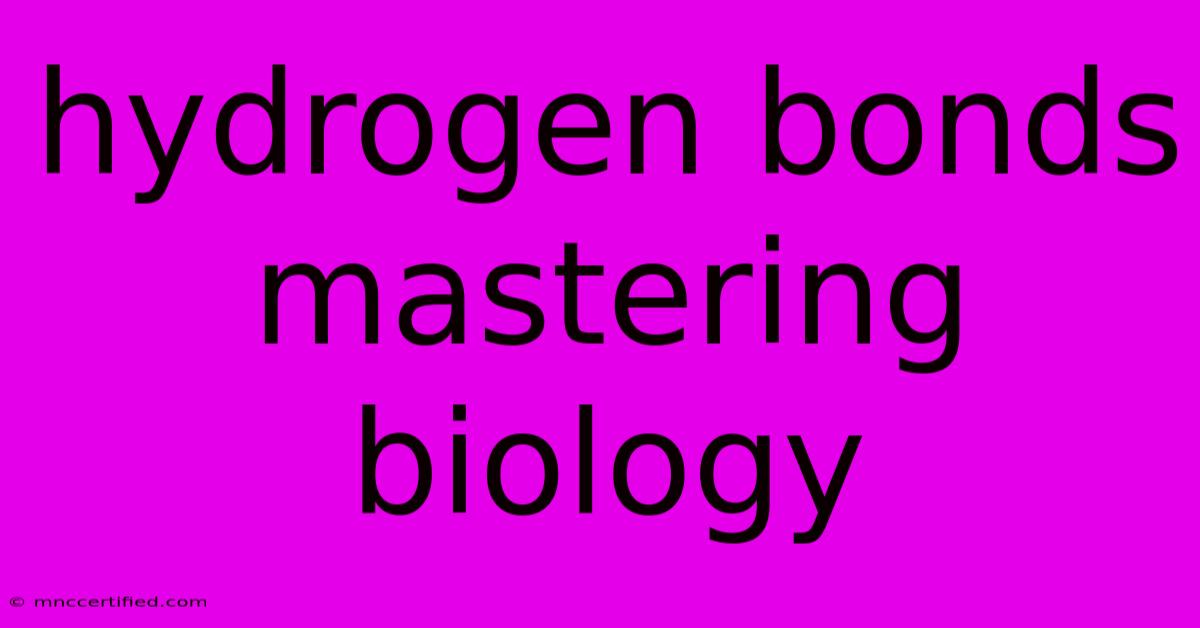Hydrogen Bonds Mastering Biology

Table of Contents
Hydrogen Bonds: Mastering Biology's Crucial Connection
Hydrogen bonds are fundamental to understanding countless biological processes. This comprehensive guide delves into the nature of hydrogen bonds, their significance in various biological systems, and why mastering this concept is crucial for success in biology. We'll explore everything from the basics of molecular interactions to the critical role hydrogen bonds play in maintaining life as we know it.
Understanding the Basics of Hydrogen Bonding
A hydrogen bond is a special type of dipole-dipole attraction between molecules, not a covalent bond to a hydrogen atom. It occurs when a hydrogen atom bonded to a highly electronegative atom (like oxygen, nitrogen, or fluorine) is attracted to another electronegative atom in a different molecule. This electronegativity difference creates a significant polarity, with the hydrogen atom carrying a partial positive charge (δ+) and the electronegative atom carrying a partial negative charge (δ−). The attraction between these opposite partial charges forms the hydrogen bond.
Key Characteristics of Hydrogen Bonds:
- Strength: Relatively weak compared to covalent or ionic bonds, but collectively they exert considerable force.
- Directionality: The bond is directional, meaning it's strongest when the hydrogen atom is aligned directly with the electronegative atom.
- Number: Multiple hydrogen bonds can form between molecules, contributing to their overall stability and properties.
The Crucial Role of Hydrogen Bonds in Biological Systems
Hydrogen bonds are ubiquitous in biological systems, influencing the structure and function of numerous molecules and processes. Let's explore some key examples:
1. Water's Unique Properties:
Water's remarkable properties—high boiling point, high surface tension, excellent solvent—all stem from the extensive hydrogen bonding network between its molecules. These properties are essential for life, enabling processes like nutrient transport and temperature regulation. Understanding hydrogen bonding is key to understanding the properties of water and its importance in biological systems.
2. Protein Structure and Function:
Hydrogen bonds are critical in maintaining the secondary, tertiary, and quaternary structures of proteins. Alpha-helices and beta-sheets, common secondary structures, are stabilized by hydrogen bonds between the amino acid backbone. Tertiary structure, the three-dimensional folding of a polypeptide chain, is also significantly influenced by hydrogen bonds between various amino acid side chains. The overall shape and function of a protein are therefore intricately linked to its hydrogen bonding network. Mastering this concept allows for a deeper comprehension of protein folding, enzyme activity, and protein-protein interactions.
3. Nucleic Acid Structure and Function:
The double helix structure of DNA is stabilized by hydrogen bonds between complementary base pairs (adenine-thymine and guanine-cytosine). These bonds are essential for DNA replication and transcription, the fundamental processes of genetic information transfer. Similarly, hydrogen bonds play a crucial role in the structure and function of RNA. Understanding hydrogen bonding in DNA and RNA is crucial for comprehending genetics and molecular biology.
4. Enzyme-Substrate Interactions:
Hydrogen bonds contribute significantly to enzyme-substrate interactions. The precise arrangement of hydrogen bond donors and acceptors on both the enzyme and substrate determines the specificity and efficiency of enzymatic reactions. Comprehending this aspect enhances understanding of metabolic pathways and cellular processes.
Mastering Hydrogen Bonds: Implications for Further Studies
A thorough understanding of hydrogen bonding is essential for advanced studies in:
- Biochemistry: Understanding metabolic pathways, enzyme kinetics, and protein folding.
- Molecular Biology: Comprehending DNA replication, transcription, translation, and gene regulation.
- Cell Biology: Understanding cell structure, membrane function, and cell signaling.
- Biophysics: Analyzing the physical and chemical properties of biological molecules and systems.
By mastering the principles of hydrogen bonding, you'll gain a deeper appreciation for the intricate and interconnected nature of biological systems. It forms a cornerstone of understanding the complexity and elegance of life itself.
Further Exploration and Resources
To deepen your understanding, consider exploring resources like advanced biochemistry textbooks, online lectures from reputable universities (like MIT OpenCourseware or Coursera), and scientific journals. Focusing on case studies that demonstrate the impact of hydrogen bonds in specific biological systems will enhance your comprehension and retention of this crucial concept.

Thank you for visiting our website wich cover about Hydrogen Bonds Mastering Biology. We hope the information provided has been useful to you. Feel free to contact us if you have any questions or need further assistance. See you next time and dont miss to bookmark.
Featured Posts
-
36 25 An Hour Is How Much A Year
Nov 21, 2024
-
Ashley Mc Bryde Honors Kris Kristofferson Cma 2024
Nov 21, 2024
-
Cheapest Sr22 Insurance Nebraska
Nov 21, 2024
-
Homeowners Insurance Metairie La
Nov 21, 2024
-
Susan Smith Parole Denied 30 Years Later
Nov 21, 2024